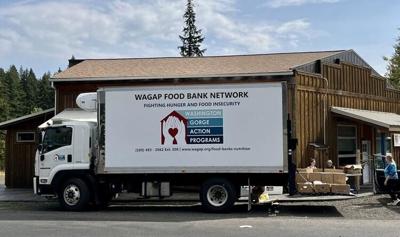BINGEN — In a surprise announcement this week, Washington Gorge Action Programs (WAGAP) learned that effective immediately, Second Harvest is discontinuing service to food assistance programs across rural communities in Washington.
WAGAP Executive Director Leslie Naramore said the Washington State Department of Agriculture (WSDA) notified her of the decision made by Second Harvest without further explanation. According to a press release, Naramore and Janeal Booren, WAGAP’s Nutrition Programs director, are scrambling to minimize the impact on their clients.
“Although this is very disappointing news, we have a tremendous network of suppliers for our WAGAP Food Bank Network, which serves people throughout Klickitat and Skamania counties,” Booren said. “The biggest impact to our clients will be access to healthy fresh foods and protein items.”
Second Harvest is a main supplier for the WAGAP Food Bank Network. WSDA reached out to Booren immediately upon learning of the decision.
Eric Williams, community partnerships director for Second Harvest, said deliveries have been suspended to more than 80 partners in 26 counties across Washington and Idaho through January.
Williams said an email sent to partners on Sept. 27 warned of supply disruptions.
"Across the country, food banks are struggling to get enough donated food. We wanted to let you know as soon as possible that Second Harvest is experiencing the same thing. Inflation and supply chain challenges combined with rising demand for food assistance means that our donated, shelf-stable food resources are being depleted faster than we can replenish them. Our team is working to restore and shore up stocks of dry goods, but we are facing some difficult choices," the email to Second Harvest's partners said.
In the short term, WAGAP may experience order disruptions, smaller orders overall or orders with perishables only.
Through WSDA, talks are underway with Clark County Food Bank to see if it can provide surplus items to WAGAP and act as a subcontractor to supplement fresh and frozen foods. This proposed arrangement could serve as a stop-gap measure to temporarily bridge WAGAP’s supply chain through March 2023.
“The goal is to have the least disruption possible,” Naramore said, “but the timing is terrible as we head into the holidays and winter.”
The writing may have been on the wall, according to a recent article by Treva Lind in The Spokesman-Review, published on Nov. 13. The article noted the empty shelves at the Second Harvest warehouse in Spokane, Wash., and shared that winter’s typical high demand, coupled with rising costs and a decrease in farm yields, are putting tremendous pressure on the nonprofit to meet its commitments.
Second Harvest supports 280 food pantries and meal sites across North Idaho and Central and Eastern Washington. The article reports a 45% increase in the number of people seeking services at the larger sites it serves between September 2021 and 2022. Inflation pressures and rising gas and diesel prices are adding to the mix as they add to the cost of transporting food, according to a press release.
WAGAP reports that Food Bank usage since 2019 has increased, and it saw a substantial increase after extended unemployment benefits ended. During the height of COVID-19, funding was available to organizations to purchase food to meet the increased need. But as the pandemic has subsided, so have budgets.
“Our real concern is whether families can afford to put food on the table,” Naramore said. “We are here to help, but we may need to make changes to cover the demand.” This week, WAGAP board members discussed options with Naramore and Booren, including the possibility of downsizing the amount of food offered in each box and getting more community involvement through home gardening and gleaning. They are weighing their options but hope to keep services as intact as possible.
Winter food drives and end-of-year fundraisers have always been fundamental to the community action agency’s ability to support its programs. Still, Booren says this unexpected withdrawal from Second Harvest, the high fuel cost for transportation, and inflationary pressures make them even more essential.
“We invite the community to pull together with us in any way possible,” Naramore said. “All donations and volunteers are welcome to help us help others in need.”
Williams said Second Harvest is seeing food go out faster than it is coming in. "A year ago, we were renting off-site space to store food — dry goods, shelf-stable. Today we have empty racks throughout our warehouses."
Recently Second Harvest spent an additional $500,000 procuring food and hired a full-time staff member singularly focused on procurement, while three additional employees have shifted half their time to focus on procurement as well, Williams said, adding that the organization is doing "everything they can to assist the front-line food banks and pantries."
In a follow-up email, Naramore said that the best donation is the one that people are able to give. “Cash is always appreciated as are food items, especially shelf-stable protein products," she said.
WAGAP is limited to Washington state for funding but can cross state lines to purchase food supplies, Naramore said
For more information, go to wagap.org or call 509-493-2662.
























Commented
Sorry, there are no recent results for popular commented articles.